How we transitioned to remote work and what will we do next
Two months have passed since everyone at the Factory switched to working remotely and in that time we’ve not just been able to get by but have managed to learn a lot and even improve our communication and daily operations.
How did we transition to working remotely in a matter of days and without a major hiccup along the way?
Keep reading and maybe find something interesting for your company.
What have we prepared for you
Have a clear decision process
Although we are mostly a young workforce (27 average years old), to protect our workers and their families, we’ve made several clear trigger points in advance to guide us in further decisions regarding switching to remote work and work organization during the COVID-19 outburst.
One of those was: As soon as the first COVID-19 case in our municipality is confirmed – we are switching to working from home.
Such triggers gave us a clear direction and saved time because when the moment came, we didn’t need to have meetings and make decisions in a rush. As soon as the first case was confirmed, we immediately all knew where we were heading and whose role is what.
Keep everybody in loop with clear, timely and transparent communication
In crisis and also in any major change, one of the key elements to overcome it successfully is clear and timely communication from the leadership. Oftentimes, the major issue with the change is fear of the unknown and not so much the change itself.
So, during the whole time, especially during the period in transitioning to remote work, each decision and step along the way was communicated to the whole company – some of it through our Slack channels and intranet, some through video calls, and for those with immediate or special circumstances, the leadership was available at any hour on cell phones and Slack.
Gather continuous feedback
Feedback is an integrated part of our culture.
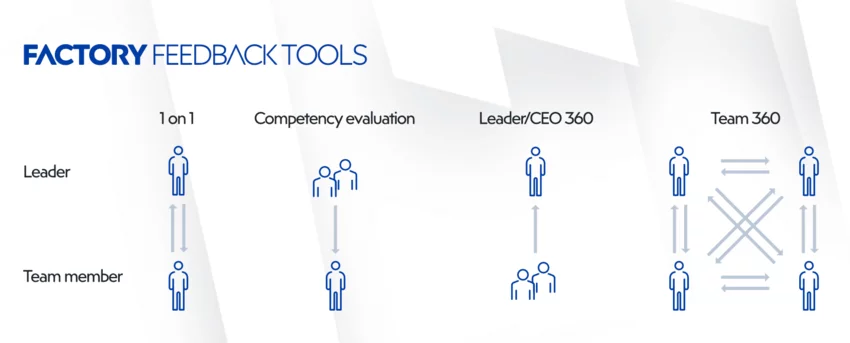
Our Team leads give regular and structured feedback to their team members every 3 months, we have a semi-annual Team 360 feedback process, and also each member has the opportunity to review and give feedback to their leaders also.
So it was natural for us to continuously gather feedback from our colleagues and check the pulse during their adjustment to the new work setup.
We had a first survey for the whole company after the first remote week to see how everyone was adjusting and to check if there were some systematic troubleshooting needed ASAP.
But surveys are not the only channel to rely upon, the leaders were daily checking the pulse of their team members and also the CEO and HR were doing the same for the leadership.
On a weekly basis, we had a leadership meeting via Hangouts and sharing feedback, good practices, and guidelines among teams.
After the first month, we ran another survey to see if something has changed for better or worse.
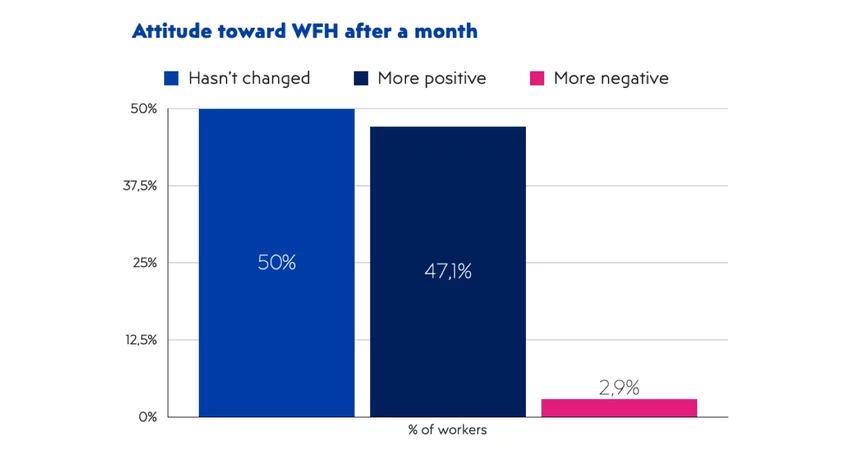
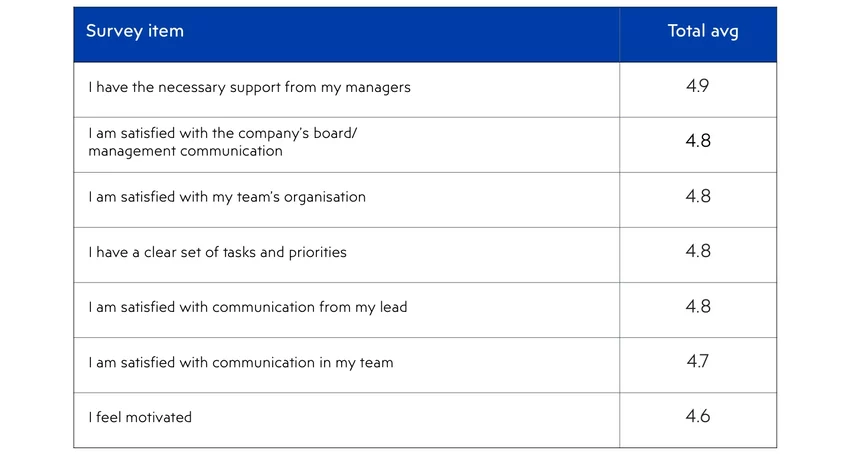
In short – we had a 100% participation rate for both surveys, and 97% of workers, after the first month, had a positive attitude toward remote work (those that said they had become more negative toward it – stated it’s mainly due to a lack of company). 94% of us had everything needed to get the job done, and in a couple of days, it was taken care of the rest and reached 100%. All areas – communication, organization, support, priorities, and motivation were highly rated (on a scale of 1-5 the min grade was 4.6).
Paint a vivid picture of the new norms with clear guidelines and support
Even before pulling the plugs in our office, we had a ready draft on how we will operate remote. We created 2 guides – one to support our management and one for the workers.
Some of the key decisions and processes were:
- Which communication channels will be used for what (for example, for complex topics we use video calls, for daily updates we use slack, for emergencies cell phones, for documentation we use google drive…)
- How to keep team organized and track progress (we’ve implemented short “dailys” and “weeklys”)
- Roles and responsibilities, who to contact in need etc.
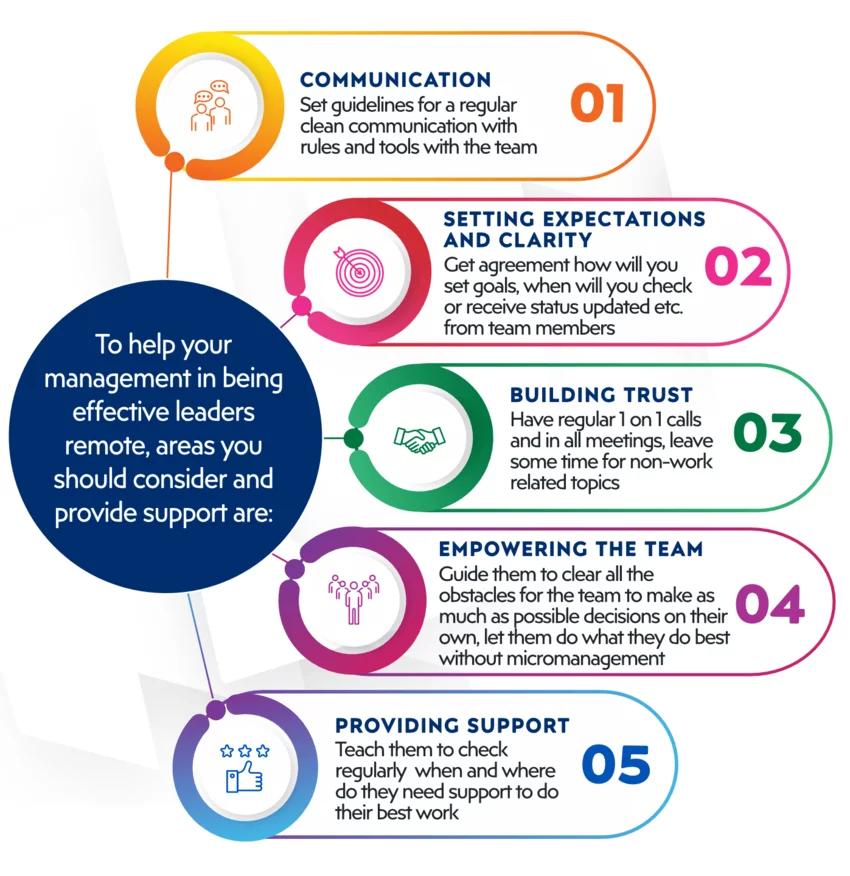
Now, we are following the same principle when moving to reopen our offices. We did extensive research on best practices and created a guide on how we will operate when some of our people start using the offices once again in hybrid meetings etc.
Involve your people in every step along the way
Each step, guide, and decision we’ve made was usually drafted by someone in leadership and then put to discussion and review by others.
When we’ve reached the consensus, then we would move to implementation.
2-way communication and giving everyone in your company a chance to speak up is important for more than one aspect: the more perspectives you have the more rounded and better output you might have, people feel more valued and in ownership of the idea, you have an overall better understanding and chance of success.
Such leadership is important in business as usual but especially in times of crisis when your people might feel worried for their health, their status etc.
Give your people what they need to do their job
When transitioning to WFH, all of our workers had a chance to bring home with them all the equipment they needed and could carry. That equipment that wasn’t so easy to carry was transported to them.
To be working from home and reaping its benefits, it’s important to have the basic stuff taken care of. By that we mean – if your workers usually do their job on an extra monitor or two, love their chair – give them a chance to take them with them. It’s a nice gesture that will benefit all.
Give your people some slack…
…and more importantly – your trust. One of the most common worries regarding remote work is that people will slack on the job and take advantage of it.
But – such worry is not justified. There are several reasons why:
- If you need to see your worker sitting behind a desk to know he is doing his job – you aren’t probably doing your job as a manager well. Having some butts in their seats doesn’t mean the work is getting done – one can just as much be playing solitaire or watching youtube.
- Research shows that remote workers usually work more and have trouble separating work from their non-work activities. Also, probably due to that common notion, in some degree, they try to prove themselves by working even harder.
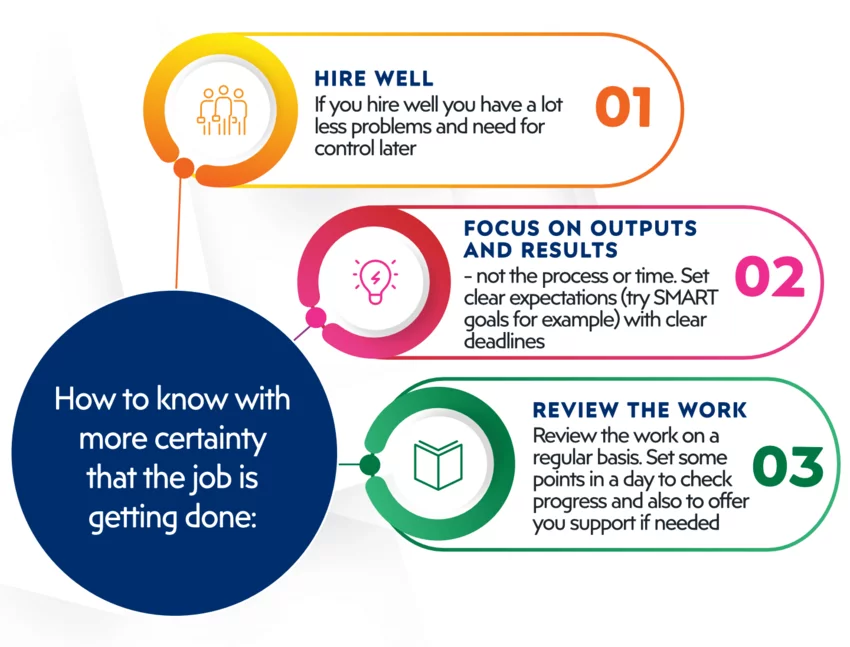
When you trust that your people are responsible adults who care for their jobs and obligations then you can give them even more flexibility and help them to be more productive. For example, some of our workers had to adjust their working schedules around family schedules and it’s something you have to take into consideration when working from home.
Try to solve the challenges you can, soothe the ones you can’t
Work from home isn’t without its set of challenges. Here are just a few:
- Maybe some don’t have the space needed for some peace and quiet where they won’t bother their household members and also be interrupted with them.
- Some might be uncomfortable with their living space being shown in each video call.
- Sometimes your internet connection will refuse to comply.
- Some can thrive being in peace and quiet by themselves and others might feel lonely.
Regarding space, you probably can’t provide your worker with a new condo (or maybe you can, that’s great :D) to have some peace and quiet. But, maybe you can give that person a more flexible schedule to work when other distractions or obligations are minimized.
For those that want to keep their privacy in video calls, one easy solution could be something like using Snap camera. You install it, set as a primary camera, choose your background and you’re set. Also, it has a lot of other fun options.
For internet troubles, you can provide your workers with some mobile internet solutions to survive while they are off the grid.
Loneliness is also one to take seriously into consideration, especially in this period. Remote work doesn’t necessarily have to be lonely cause you can have a lot of social connections outside of work. But when you have work from home in the midst of a global quarantine, people are deprived of not just their coworkers but probably from their friends, family, and other significant people.
So, daily team meetings, 1 on 1 calls, online watercoolers as an alternative to spontaneous meetings in the office kitchen or breaks, quizzes, and similar multiplayer games can help.
Try to be creative and instill some fun in your workers’ day. But don’t push it, make it non-obligatory.
Some of those we have in place and for some, we will try to implement as soon as possible. One tool that some of our teams started using is Discord. You can think of Discord as an audio Slack. As in Slack, you have channels (rooms) you can join, you can also write – but primarily you can create “audio rooms” where people can come in, spend the whole day if they want, share their music or just talk.
We are keeping remote indefinitely
We went from a remote skeptic to a true believer in 2 months and we feel we did a pretty darn good job for a company that usually shied away from working remote.
Again, when contemplating when and how to return to our offices, we had a look at our data, had an open discussion, and did extensive research about good practices and what to look after in the process.
“I have a much more positive attitude towards remote work because I’m assured that with good communication, we can be even more productive.”
- Alen J., Backend developer
“I really liked remote work and as time goes by, I like it even more. In the beginning, I wasn’t exactly sure if it would efficient. But after 1 month of remote work, I’m delighted how the communication, task delegation, and work are still being executed at a high level, just like in the office.”
- Petar Š. Frontend developer
Also, we took great care to take into account all the specific groups among our colleagues that could need more care and flexible approach (parents who still don’t have a daycare, those who are in a health risk group or have family members in risk, those that have to use public transport and potentially expose themselves to greater risk etc.).
The final decision was to keep the remote work and all newfound benefits indefinite.
Those colleagues that look forward to coming back to our offices will have a chance to do so in a matter of days as soon as we prepare them for their safe return. All others will have a chance to keep working remotely as long as they see fit.
Important thing is to give your people flexibility and not to dive from one extreme to another just because it’s “the new thing”. Some love working remotely and others need to get out of the house, mingle, and have face to face interactions.
Why are we happy with our performance during this period?
- We’ve improved our communication and daily operations; we have kept clear priorities with less but more focused meetings,
- Kept going with our first iOS academy remotely that’s about to come to an end soon
- Started with a whole new Frontend academy and got an amazing response (100 attendees in our Intro webinar and 66 candidates for the Academy that’s about to start soon)
- Switched the whole selection process remotely while keeping our criteria high and quality of candidates
- Onboarded new colleague
- In final steps of hiring 2 new colleagues
- Promoted several of our colleagues
These 2 months have been challenging but we are proud that every week behind us has been more and more successful. Together we’ve overcome many obstacles and are looking forward to seeing what awaits us in the coming months and how it will impact the way of doing business.
If you find this interesting or want to find out more, feel free to reach out! If you want to check out what opportunities are there for joining our company – check our career page 🙂






